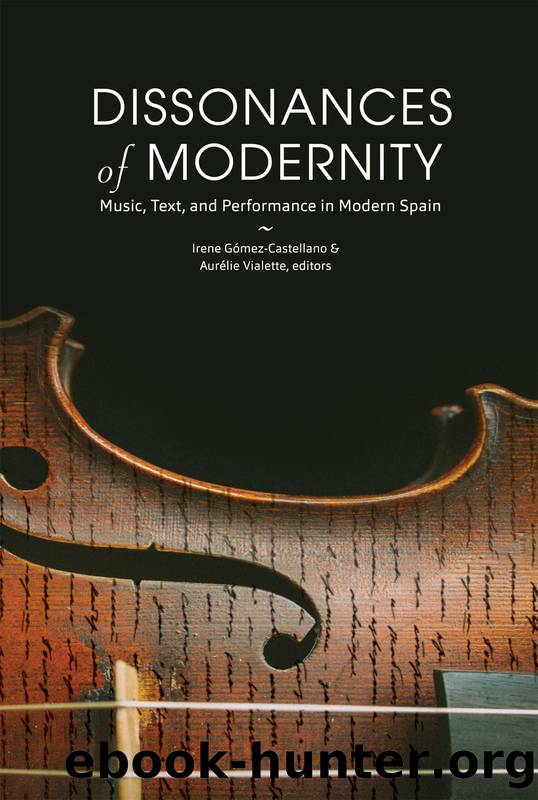Dissonances of Modernity by Irene Gómez-Castellano

Author:Irene Gómez-Castellano
Language: eng
Format: epub
Publisher: University of North Carolina at Chapel Hill Department of Romance Studies
Published: 2021-01-15T00:00:00+00:00
PART II:
ZARZUELAS AND THEATER: DISSONANCES OF MODERNITY ON STAGE
MUSIC, TEXT, AND PERFORMING CULTURAL IDENTITY IN FRANCISCO BARBIERIâS (1823â1894) EL BARBERILLO DE LAVAPIÃS (1874)
YURI PORRAS, Texas State University
HISPANISTS who have studied the nineteenth-century zarzueÂ-la mostly regard it as one of the most prolific lyric theatrical aesthetics of its time, and in spite of a relatively recent flux of puÂblished works on the subject, both in Spain and parts of Latin America, scholarship has not quite given this genre its due.1 That zarzuela is inherently interdisciplinary makes it difficult to appreciate its cultural ramifications without studying both theatrical and musical components. In-depth studies on even the most popular and successful representations of the genre, or of its composers and librettists are not always easily accessible, and analyses on the various ways in which music and text interrelate structurally and ideologically even more elusive. It is precisely this void in criticism of thousands of extant zarzuelas (Webber xi), which flourished primarily during 1850â1950 and still performed to this day, that both literary criÂtics and musicologists alike must address. The genre became a space wherein composers and librettists searched Spainâs music-literary tradition from which to reestablish an authenticity through ânativeâ lyric theatrical form, to resist foreign operatic influences considered by a sector of society as models to imitate. It is in Francisco Barbieriâs El barberillo de Lavapiés that we find the crystallization of a genre in whose music and libretto there is precisely this constant dissonance that mimics the struggle for the soul of the nation. Based on the critical edition of MarÃa Encina Cortizo and Ramón Sobrino, as well as on the 2004 performance directed by José LuÃs Moreno, this essay aims to discuss some of the structural, technical, and ideological functions of songs, instruments, and dances in El barberillo de Lavapiés, to illustrate how Zarzuela, as a genre, became a process of cultural hybridity from which a notion of âSpanishness,â that is to say, a sense of national identity continued to evolve.2
Scholars believe the name âzarzuelaâ was inspired in the seventeenth century by the picturesque palace filled with beautiful gardens where King Philip IV, himself a musician, eventually came to hold his âfiestas de la zarzuela.â In this sense, it was meant originally to entertain the monarch, particularly during times when he was unable to hunt (Cotarelo y Mori 43). The basic ingredients of what would later be known as zarzuela, however, were already sprinkled throughout the earlier theatrical works of figures from Juan del Encina, Lucas Fernández, and Gil Vicente, to Cervantes, Lope de Vega, and Calderón (Chase 36).3 The latter two were especially important, Lope, with what is considered the first Spanish opera, La selva sin amor, of which no music survives, and Calderónâs legacy of early (Baroque) zarzuela, such as El golfo de las sirenas, El laurel de Apolo, La púrpura de la rosa, La estatua de Prometeo, and Celos, aún del aire matan, which were created in collaboration with court composer Juan Hidalgo (1614â1685). Zarzuela in the seventeenth
Download
This site does not store any files on its server. We only index and link to content provided by other sites. Please contact the content providers to delete copyright contents if any and email us, we'll remove relevant links or contents immediately.
The Power of Myth by Joseph Campbell & Bill Moyers(1000)
Half Moon Bay by Jonathan Kellerman & Jesse Kellerman(951)
A Social History of the Media by Peter Burke & Peter Burke(935)
Inseparable by Emma Donoghue(921)
The Nets of Modernism: Henry James, Virginia Woolf, James Joyce, and Sigmund Freud by Maud Ellmann(833)
The Spike by Mark Humphries;(764)
The Complete Correspondence 1928-1940 by Theodor W. Adorno & Walter Benjamin(746)
A Theory of Narrative Drawing by Simon Grennan(742)
Culture by Terry Eagleton(711)
Ideology by Eagleton Terry;(696)
Bodies from the Library 3 by Tony Medawar(680)
World Philology by(673)
Farnsworth's Classical English Rhetoric by Ward Farnsworth(672)
Game of Thrones and Philosophy by William Irwin(669)
High Albania by M. Edith Durham(654)
Adam Smith by Jonathan Conlin(648)
A Reader’s Companion to J. D. Salinger’s The Catcher in the Rye by Peter Beidler(646)
Comic Genius: Portraits of Funny People by(616)
Monkey King by Wu Cheng'en(609)
